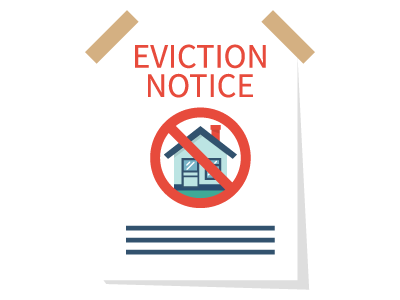The Eviction Process for Tenants
- Tenants must be given at least two months' notice under Section 21 of the Housing Act 1988.
- Top Tip: With no real control over when a tenant vacates, if you're selling, it is best not to exchange until the property has been vacated.
- If the tenant does not move out 2 months after serving the section 21 notice, you'll have to go to court to seek a possession order.
- Making sure the tenant receives the Section 21 notice is an important part of the eviction process.
The eviction process for tenants can be a daunting experience for both landlords and tenants in the UK. Understanding the legal framework, in particular Section 21 of the Housing Act 1988, is crucial for landlords seeking to regain possession of their property.
When selling a property with a tenant, you can either transfer the tenant to the new landlord or you can evict them and sell the rental property with vacant possession.
Although some landlords might like to buy the property with a tenant so as not to lose any rental income, others want a fresh start with vacant property which they'll fill with their own tenant.
These are the 3 steps to evict a tenant and if you need help then please get in contact as our solicitors can handle the conveyancing for the sale and the eviction of the tenant.
- 1
Evicting a tenant under the Section 21 eviction notice
You must give your tenant at least two months' notice under Section 21 of the Housing Act 1988 if you want to evict them - this is known as a Section 21 notice.
Section 21 serves as a legal mechanism to help landlords seek possession of their property, without having to prove fault on the part of the tenant, otherwise known as a "no-fault" eviction.
The Renters' Reform Bill passed in the House of Commons on the 24th of April 2024. It included an amendment from the government that postpones a ban on the "no-fault" section of Section 21 evictions until a review of the court system occurs.
Usually, this written notice period is used to ensure the landlord can sell the property, move into the property themselves, or repossess it for renovation purposes.
The notice can only be served by a landlord earlier than any fixed term if the tenancy agreement makes provision for it.
There isn't a prescribed format for the serving of the notice, however it must be:
- In writing; and
- Specify the date of required possession (which cannot be less than 2 months or earlier than the end of the fixed term).
If the fixed term has expired, or the tenancy was periodic, the date specified on the tenant's notice must be the last day of the rental period.
It's very easy to get the date wrong in this situation, so be careful because if the eviction date is wrong, then you won't succeed in possession.
For example, if the fixed-term tenancy ends on the 31st of December, then this is the eviction date included on the section 21 notice and the date of possession is the 28th of February.

Assured agricultural occupancy
An assured agricultural occupancy is governed by the Housing Act 1988, giving the occupier a similar form of protection as a fully assured tenancy.
In these instances, the landlord can only evict the tenant in limited circumstances by proving grounds.
What counts as agricultural work?
- Forestry
- Use of land as grazing, meadow, or pasture.
- Dairy farming and keeping/breeding of livestock.
- Production of consumable produce for sale or consumption.
- Use of land for market gardens or nursery grounds.
If a possession order is made within six months after a tenancy ends against agricultural workers without assured occupancy, the court could suspend the order for the rest of the six months.
Not all rural activity counts as agricultural work; working in a farm shop is not applicable here.
Should you exchange contracts with a tenant still in the property?
In most conveyancing contracts it'll state as a special condition that the property is sold with vacant possession. Read more here on what is vacant possession?
If the seller exchanges when there is still a tenant in the property, but the contract stipulates that they have to give vacant possession - if the tenant hasn't moved out before the end date of the exchange - the seller is in breach of contract. Read more on what happens and the costs involved when a seller fails to complete.
With no real control over when a tenant vacates, it is best not to exchange until the property has been vacated; then look for as little time between exchange and completion to limit the vacancy without making any rent payments.
- 2
Possession Order and court hearing
If the tenant does not move out 2 months after serving the section 21 notice, you’ll have to go to court to seek a possession order.
Serving a 'tenants notice' is a critical step in eviction, specifically referring to the Section 8 notice seeking possession under the Housing Act 1988. This involves informing tenants of the breach of tenancy terms and initiating the eviction process.
For an assured shorthold tenancy, you need to have grounds for eviction and to have served the proper notice period on the tenant before possession proceedings can start.
There are several mandatory grounds for a possession order, however, the most common two are for assured shorthold tenancies and rent arrears.

Assured shorthold tenancies
If the tenancy is an assured tenancy, you are entitled to a possession order after the fixed term has expired, provided the proper Section 21 notice has been served.
Rent arrears (unpaid rent)
If there are serious rent arrears at the time of service of the notice (Section 8 notice), and at the time of the court hearing, the tenant is in arrears of rent of more than eight weeks.
A Section 8 notice requires possession because of rent arrears, but most private landlords use the Section 21 eviction process because they do not have to provide a legal reason.
Ever wondered how you could reduce your income tax on rental property? Read our article which goes through the different strategies you can implement to help.
Eviction by court bailiffs
A landlord can ask court bailiffs to evict a tenant if they have not left by the date on the court order.
It can take another few weeks before a new eviction date is written up, but all county court bailiffs or high court enforcement officers (HCEOs) must follow strict procedures and give at least 2 weeks’ notice of the eviction date.
Before reaching this stage, landlords must first serve a 'notice to quit' as part of the legally required steps.
- 3
Accelerated Possession Order
You can also opt for an accelerated possession order which is a faster way to gain possession as there is no court hearing, however, you have to pay a fee before the court action can commence.
To start the process for accelerated possession, you'll need to contact the County Court in the area where your property is situated, then fill in a Form N5B claim for a suspended possession order (accelerate procedure), obtainable from HM Courts service.
Once the form is received at court, they'll post the papers to the tenant, along with a form of reply allowing them to object within 14 days if they wish to.
If you are successful then the court issues an order for possession (normally enforceable 14 days after the order was made) and an order that the tenant pay the court fee.
From the issue of proceedings to receipt of the order for possession, these proceedings normally take between 6 and 10 weeks assuming nothing goes wrong.

Tenant rights and protections
It's essential in this process to recognise the rights and protections afforded to tenants under the law.
Tenants have the right to challenge a Section 21 notice if they believe it has been served incorrectly, so landlords need to provide tenants with the required notice period and protect their deposit within a government-approved scheme.
Important: serving the written notice to the tenant
Making sure the tenant receives the Section 21 notice is an important part of the eviction process.
Sometimes a tenant won't answer the door so they can't have notice served to them. You can deal with this by taking a witness with you whilst you post the section 21 notice through the letterbox before 5 pm. If you do this, the notice is deemed to have been served on the following day.
Andrew started his career in 2000 working within conveyancing solicitor firms and grew hands-on knowledge of a wide variety of conveyancing challenges and solutions. After helping in excess of 50,000 clients in his career, he uses all this experience within his article writing for SAM, mainstream media and his self published book How to Buy a House Without Killing Anyone.
Caragh is an excellent writer and copy editor of books, news articles and editorials. She has written extensively for SAM for a variety of conveyancing, survey, property law and mortgage-related articles.









